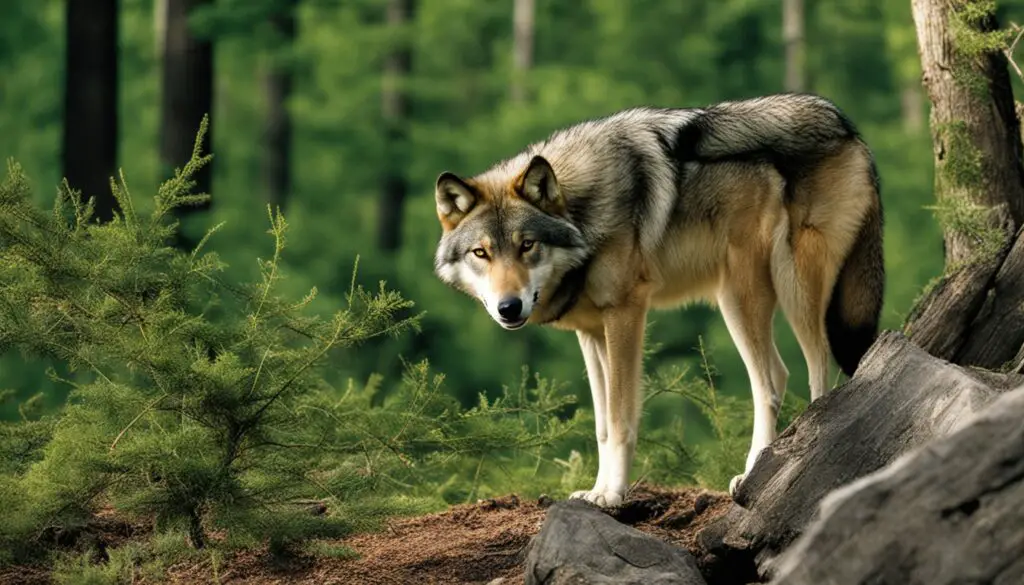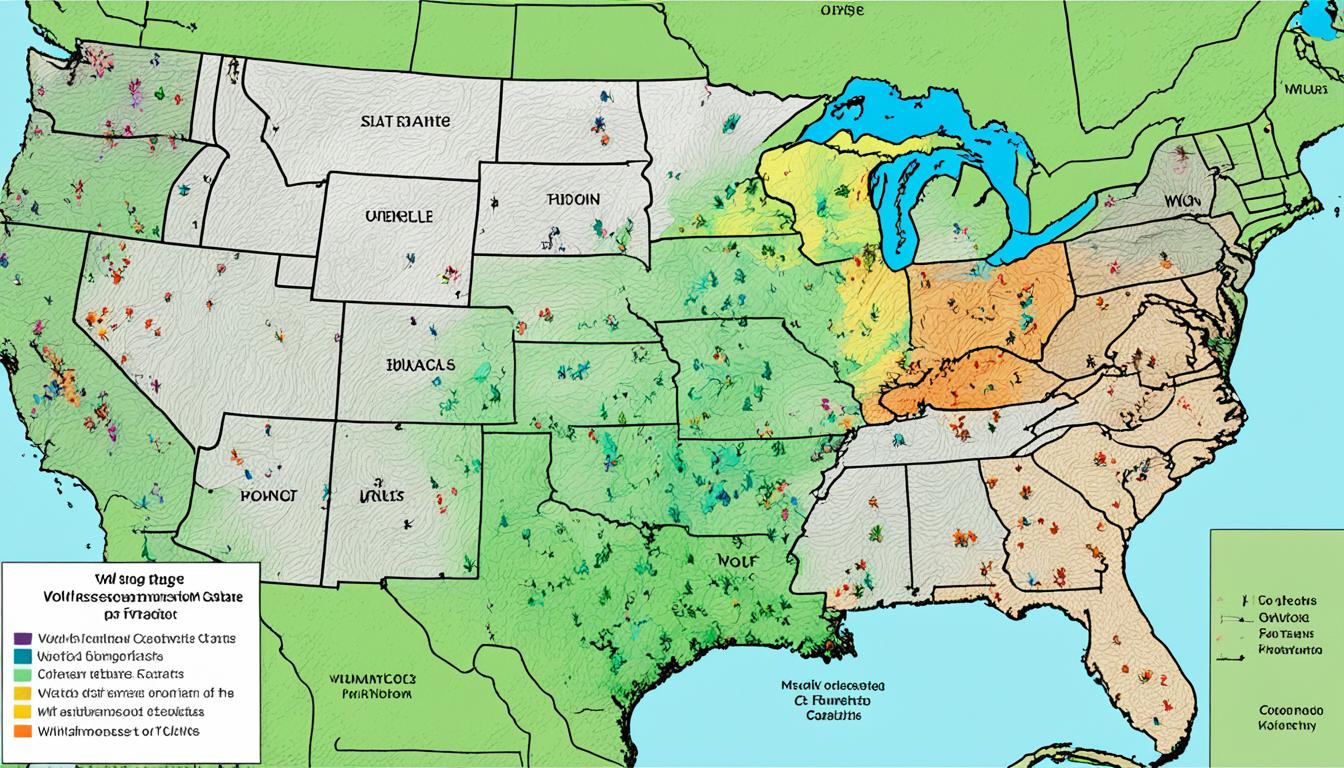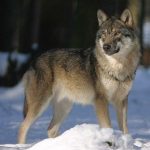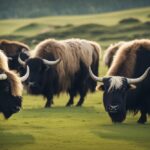Imagine the legendary wildlife of the United States. Do you picture majestic wolves running in the wild?
You might not know, but the wolf numbers in the US have been increasing. This growth is thanks to focused efforts on conservation and recovery. Now, you can find wolves thriving in places like the Pacific Northwest, Northern Rockies, Southwest, and Great Lakes region. Here, the native wildlife of the USA is being restored.
This revival includes subspecies like the Northwestern wolf, Mexican gray wolf, and Great Plains wolf. They are making a comeback in states like California, Oregon, Washington, and North Carolina. Efforts in the Northern Rockies and Great Lakes have been very successful. And in Alaska, wolves continue to be very strong.
Explore more about these amazing animals and their habitats in the next sections.
History of Wolves in the USA
The story of wolves in the United States mixes both conflict and conservation. In the early 1900s, nearly all wolves were killed off. This was due to efforts to protect livestock by removing the wolves.
Predator-Control Programs
In the 1900s, predator-control was very aggressive. People killed wolves in large numbers to protect their animals. Sadly, this led to wolves becoming almost extinct in many places.
Endangered Species Act
Things changed in 1973 with the Endangered Species Act. This new law marked the beginning of a more hopeful chapter for wolf conservation. It listed the gray wolf as a protected species, which meant they received full support to recover.
The ESA became a key step for bringing wolves back to places they were lost. It was the start of efforts to reintroduce them into their former habitats.
Timeline of Recovery Efforts
In the 1990s, reintroducing wolves gained momentum. This took place in areas like Yellowstone and the Northern Rockies. These efforts have succeeded greatly over the years. So much so, that some places have seen enough wolf recovery to no longer be considered endangered.
States such as Wyoming and the Northern Rockies saw a big return of wolves. This led to their endangered status being removed in some areas.
| Year | Event | Impact |
|---|---|---|
| 1900s | Predator-Control Programs | Drastic reduction in wolf populations across the contiguous US |
| 1973 | Endangered Species Act | Gray wolf listed as endangered, leading to federal protection and recovery plans |
| 1990s | Reintroduction Efforts | Wolves reintroduced to Yellowstone and Northern Rockies |
| 2000s-Present | Continued Conservation Efforts | Delisting in specific regions due to successful population recovery |
Current Wolf Population in the USA
The wolf population in the USA has grown a lot thanks to dedicated conservation. Places like the Pacific Northwest, Northern Rockies, and the Southwest & Great Lakes have shown big improvements. Grey wolves are coming back to these regions because of successful projects. They are returning to their natural homes.
Pacific Northwest
The Pacific Northwest is working hard on wolf conservation. States such as California and Washington see more wolves returning. This is a big win for wolf numbers. People in these areas now have a chance to see these amazing animals. For anyone interested in seeing wolves, this region is a great place to visit.
Northern Rockies
The Northern Rockies have also done well in keeping wolf numbers up. Idaho, Montana, and Wyoming’s management has been key. Seeing wolves in their own habitat is common in this area. It shows that when people work together, wolf populations can grow in positive ways.
Southwest & Great Lakes Regions
In the Southwest, there’s the Mexican gray wolf. Efforts in Arizona and New Mexico are crucial for their survival. They help grow the overall wolf population in America. The Great Lakes Region, on the other hand, has exceeded its wolf goals. Success here has been due to good management and habitat care.
These areas are perfect for nature lovers and anyone who wants to see wolves in the wild. The increased wolf numbers show their comeback ability. Many hardworking teams in conservation are making this happen nationwide.
Are there wolves in the USA?
Wolves are a vital part of America’s ecosystem, found in many places with a known wolf history. This shows their wide return. Efforts include reports and tracking, proving how active people are in watching over them.
Wolves have been sighted in Michigan, Minnesota, and Wisconsin, adding credence to wolf presence in the US.
In the West, states like Oregon, Washington, and California have also seen many wolves. These areas have played a big role in the wolves’ comeback success. This is a good sign for their population growth.
Experts are closely following these beautiful animals. This work gives us critical information, showing the importance of wolves in America. Ongoing monitoring helps protect wolves throughout their territories.
Grey Wolves in America
Grey wolves in America thrive in many places. They adapt well to different habitats. Their life depends on where they live, what they eat, and how they look.
Habitat & Range
These wolves can be found in many places like forests and tundra. Their home includes mountains and grasslands too. Each area gives them what they need to survive. This includes food and places to hide when hunting.
Diet & Hunting Patterns
Grey wolves eat animals like elk and deer. They often work together to catch big prey. This teamwork helps them stay well-fed, even when food is scarce.
Physical Characteristics
Grey wolves are built for hunting. They have long legs and powerful jaws. Their keen sense of smell and sharp ears help them find food. Their coats can be white, black, or shades of gray, helping them blend in.
| Characteristic | Description |
|---|---|
| Habitat | Forests, mountains, tundra, and grasslands |
| Diet | Elk, deer, and moose |
| Physical Traits | Long legs, large skulls, powerful jaws, keen senses |
| Pelt Color | White, black, various shades of gray |
Wolf Population in the US by Region
The US has a lot of wolves, but their numbers vary by region. The Western Great Lake states see a big wolf population. They’ve been growing in numbers a lot. Next up is the Northern Rocky Mountain region. Management efforts there have also helped wolf numbers recover.
In the Pacific Northwest and the Southwest, we find other big wolf numbers. Each place has its kind of wolf and their own issues. This shows us how wolf populations vary and grow across different parts of the US.
Conservation efforts
in the Southeastern states are focused on saving the red wolf. This kind of wolf is in real danger and there are not many left. North Carolina has an important population of these wolves. Here’s a closer look at how many wolves are in different parts of the US:
| Region | Subspecies | Conservation Status |
|---|---|---|
| Western Great Lakes | Gray Wolf | Recovered |
| Northern Rockies | Gray Wolf | Recovered |
| Pacific Northwest | Gray Wolf, Coastal Wolf | Vulnerable |
| Southwest | Mexican Gray Wolf | Endangered |
| Southeast | Red Wolf | Critically Endangered |
It’s important to understand these differences for conservation. We want to see wolves recover in their areas. As we learn more about where wolves live in the US, we see how vital it is to watch them closely. This helps keep wolf populations healthy in different regions.
Wildlife in the United States: Importance of Wolves
Wolves are key to keeping America’s ecosystems in harmony. They are at the top of the food chain. This means they play a big part in keeping nature healthy. It’s essential to understand why wolves matter in nature.

Ecological Role
Wolves have a big effect on their environment. They keep the number of deer and elk in check. This stops these animals from eating too much and harming plants. This helps keep different plants and animals living in the area, also known as biodiversity.
Interactions with Other Species
Wolves’ hunt helps create a stronger and more diverse ecosystem. This makes nature more interesting and able to cope with change. Wolves also impact where animals live and how they act. This helps with keeping habitats healthy and in balance.
“The return of wolves to Yellowstone National Park has fundamentally transformed the landscape, indicating the far-reaching wolf ecological impact,” said Dr. Doug Smith, Yellowstone National Park’s Senior Wildlife Biologist.
| Aspect | Impact |
|---|---|
| Prey Population Control | Maintains balanced prey numbers, preventing overpopulation |
| Biodiversity | Increases species variety by promoting different plant and animal life |
| Habitat Health | Enhances plant regeneration and reduces erosion |
| Predator-Prey Dynamics | Equilibrates the food chain through predator-prey interactions |
Reintroduction of Wolves in Different States
The return of wolves to various areas has deeply changed ecosystems and life forms. Large effects are seen in Yellowstone and the Pacific Northwest.
Yellowstone National Park
The rebirth of wolves in Yellowstone marks a key conservation win. These wolves have not just survived but helped the park find its natural stability again. The success wolf reintroduction success boosted the number of different species and bettered the places they live.
Pacific Northwest
In the Pacific Northwest, the comeback of wolves has been a big success for wildlife. From Washington to California, wolves have gone back to old lands and made ecosystems healthier. Their comeback fixes the balance between animals that eat and those who are eaten, which helps the environment in many ways.
The work to bring back wolves in these areas is crucial. It shows how wolves play a big part in fixing the circle of life in nature. The stories of Yellowstone’s wolves and the benefits in the Pacific Northwest highlight why saving wolves matter. This wildlife recovery push should keep going strong.
Conservation of Wolves in the USA
Wolves are key for the balance of nature. Efforts to save them in the USA involve federal and state groups. The Endangered Species Act is a big part, giving legal protection to wolves. Thanks to these actions, wolf numbers have grown in many places.
Ongoing Conservation Efforts
Many groups work to save wolves. They help them go back to where they belong and make sure they are okay. People also learn how to live with wolves better, helping everyone get along.
State and Federal Protections
The work of both federal and state levels is crucial for wolf protection. The Endangered Species Act keeps them safe everywhere. But, states can also make their own plans to help wolves based on local needs. This teamwork is vital for the lasting success of wolf conservation.










